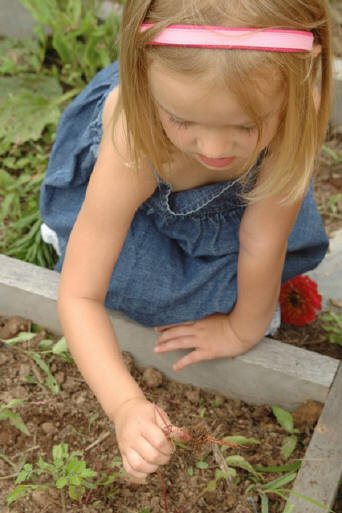One day Mrs. Jones was working in her garden thinning beet seedlings with her son keeping her company. As she plucked seedlings to allow optimal growth, her son followed behind. When she got to end of the row she realized that he too was thinning the beets and that there was nothing left in the row at all except an opportunity to replant beets.
"What could I do? If I had reprimanded him, he never would have wanted to spend time in the garden with me."
Mrs. Jones and I share the same sentiment. It is my firm belief that if you want children to spend time with you in the garden, it is essential to adopt an attitude of flexibility and embrace the less than perfect ideal. I have found that if I apply three basic ideas, everyone is happier.
|

Raised beds in the garden reduce
trampling by youngster’s feet.
|
First, there is an essential to do list and then there is a wish list. I found that if I saved the essential tasks for when the kids were occupied elsewhere, I was able to do what I needed in a fraction of the time and without having my efforts undone. If you have something you need to accomplish, that might be best saved for when young ones are napping, asleep for the
night, or better yet, at someone else’s house.
Second, if there are areas or plants that are really important to you that you want to protect, block them off. I used a combination of stakes and strings, bird netting, raised beds, and paths. I used mulch and straw paths and laid temporary bricks or stones to direct their footsteps. Sometimes I would lay boards through the beds in the places where I wanted them to
walk. We used to call it "walking the plank". It always amazed me that children gravitated towards walking on a narrow board, trying to balance as they went. Although these efforts did not exclude trampling and potentially destructive explorations, it did reduce damage.
Third, and most importantly, show children what they can do. Show them what they can pick, where they can go, what they can smell. I used to give children packets of outdated seeds that they could sow or throw. For me, it didn’t matter what, if anything, became of them because my expectations were kept low. One year, we were lucky enough to have pumpkins for Halloween
because the children, apparently, planted them in exactly the right place at exactly the right time. The seeds that I planted did not fare so well.
It can be difficult and quite frustrating to try to accomplish essential garden tasks with young "helpers". In the end, it is not the completion of a to do list that matters. What really matters is that we sow enthusiasm for gardening and things of nature. If our goal is to complete a pre-determined task in the garden with young children present, we may be
disappointed. If, however, we lower our expectations and focus instead on the opportunity to spend quality time with children in the garden while that short and magical time lasts, we will be greatly fulfilled.
Read other articles by Susie Hill